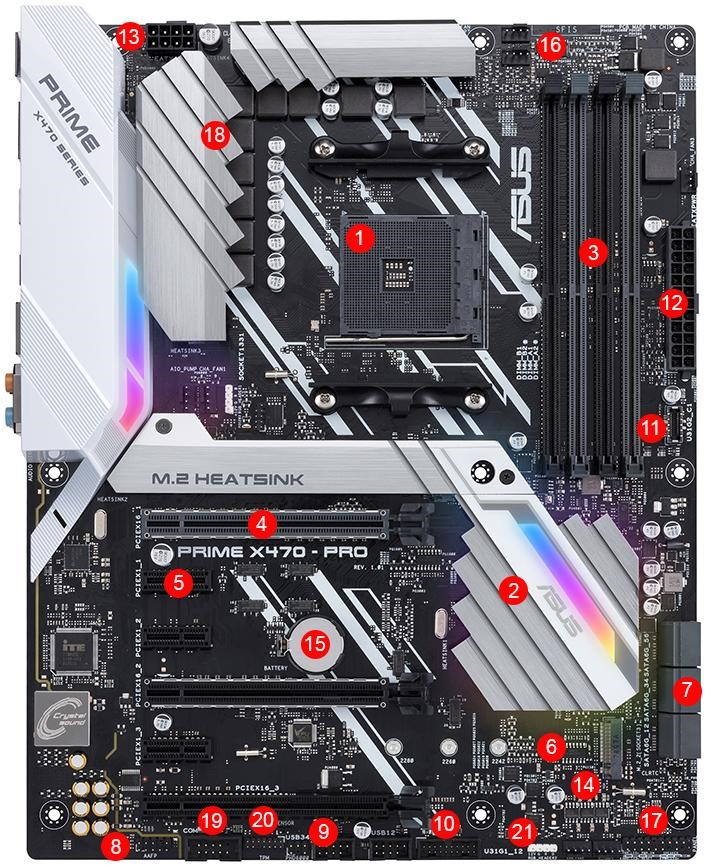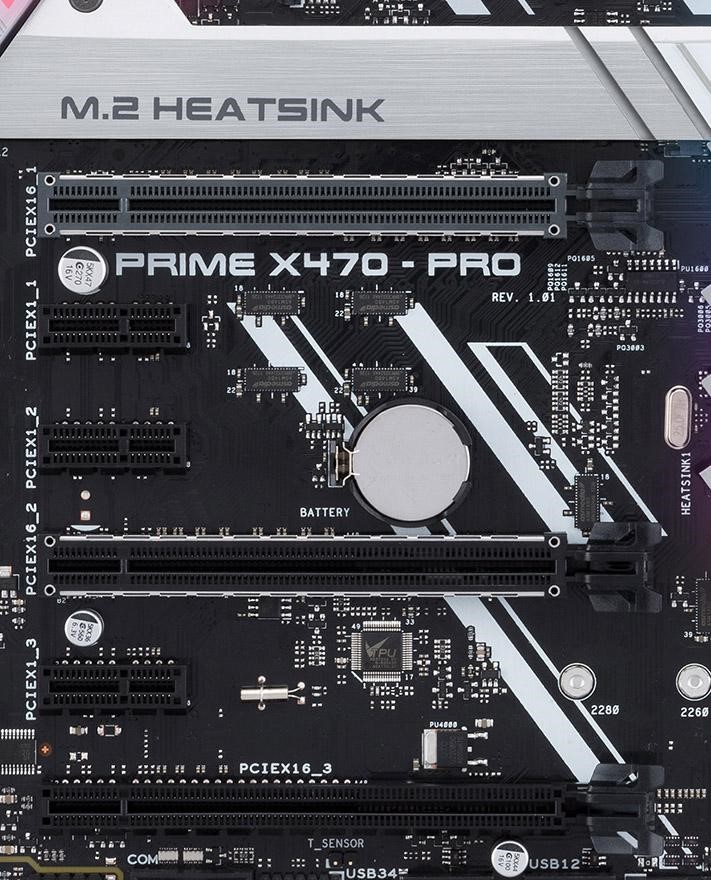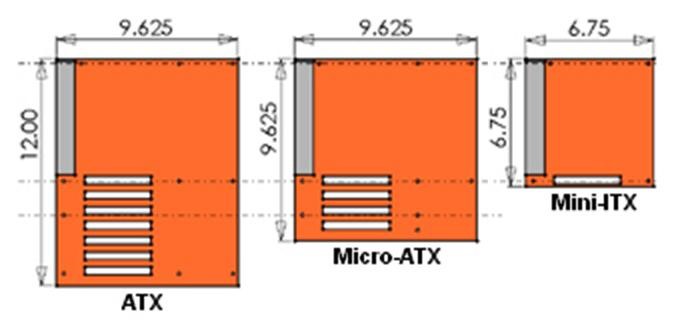Reviewing the Basics Chapter 3 Answers All About Motherboards 9th Edition
Dissecting the Modernistic Motherboard: Connectors, Ports & Chipsets Explained
If you don't know exactly what you're looking at, motherboards—particularly loftier-end models—can expect more like the Transformers' home world of Cybertron than something y'all might plug your drives, CPU, and graphics cards into. And with dozens of models available for nigh platforms, unless you're up on all the lingo and the latest tech, it can be tough to know where to start.
Below we'll diagram most of the major ports, headers, and slots mutual on today's motherboards, followed by some helpful basics virtually expansion slots, RAM, and motherboard grade factors. For more detailed communication, check out our motherboard ownership guide.
Motherboard Diagram
Allow's take a look at a typical higher level motherboard for an example of connector and port types. We chose the Asus Prime X470-Pro for its inclusion of many modern motherboard features, and its contrasting color design, which makes information technology easier to run across smaller board components.

| one. CPU socket | 2. Chipset | 3. DIMM/RAM slots |
| 4. PCIe x16 slot | 5. PCI x1 slot | half dozen. M.two connector |
| 7. SATA ports | eight. Front panel connectors | 9. USB 2. header |
| 10. USB three.1 Gen1 header | 11. USB 3.1 Gen2 header | 12. ATX power connector |
| xiii. CPU power connector | fourteen. BIOS chips | 15. CMOS bombardment |
| 16. Fan headers | 17. Front end panel header | 18. VRM heatsink |
| 19. COM/Serial header | 20. TPM header | 21. RGB header |
Higher up we've illustrated many of the common motherboard port and connector types. Of course, not all boards characteristic all types, and things similar fan headers, K.two connectors, and the BIOS battery will exist located in dissimilar spots on different boards.
Likewise note that the M.two connector (#half-dozen in our diagram above) may have up to four PCIe three.0 or 2.0 lanes feeding to it. Today'southward fastest NVMe drives employ four PCIe lanes for maximum speed, just some (like MyDigitalSSD'south SBX drives) utilise simply two lanes to hit lower price points while still being much faster than SATA drives.
Alternatively, an M.two slot may only connect to SATA lanes/drives, or it may support both SATA and NVMe/PCIe drives. So be certain to check what the board'due south M.two connectors are capable of earlier buying a bulldoze. For more virtually fast storage, exist sure to check out our SSD ownership guide.
Expansion Slots
These days, nigh motherboards feature just two slot types: the long PCIe x16 and the short PCIe x1 slot. Yous may occasionally see an x4 slot (which sits between those two in length, but they're pretty rare. And since you can install an x4 or an x1 card into an x16 slot, x4 slots aren't all that useful unless you're holding on to an erstwhile expansion card (that somehow has modern drivers) and you want to apply your x16 slots for graphics cards.

Note that some PCIe slots may exist wired for fewer lanes than the slot length suggests, or take some lanes disabled depending on what other slots or fast drives are installed. Also know that slot organization/spacing is key if installing more than one or 2 expansion cards. In the image above, if y'all install a gaming graphics card (the vast majority of which are at least 2 slots alpine) in either of the ii x16 slots, the shorter x1 slots below them will exist blocked. So while there are 6 slots on the board here, if you install two graphics cards, you'll have just two attainable slots to add other cards.
If you are planning on installing lots of expansion cards, you'll desire to opt for an ATX motherboard (if not an E-ATX model), equally smaller grade factors have less room for slots (as well as other features that take up lots of PCB space). Even if a smaller board has all the slots and ports you need now, it's expert to have some left over for future upgrades.
Lastly, a annotation near metallic-wrapped PCIe slots: These are increasingly common in high-end and fifty-fifty mainstream boards. The thought is that they provide more than support for big graphics cards, to keep the plastic slot from keen or outright breaking under the weight of heavy cards. Nosotros accept seen slots interruption before--ordinarily when large cards are installed in a system that's been shipped across the land. But unless you are going to ship your system, or plan to cart it to LAN parties and you take a very big, heavy menu, metal slots are more for show than a necessity.
Retentiveness
Mini-ITX motherboards are usually limited to 2 RAM slots due to board infinite constraints. Some depression-end chipsets are as well limited to two slots, considering simply one DIMM per channel is supported. If y'all need more than, you'll need to opt for a board with at least four DIMM slots. Many boards based effectually high-finish chipsets (X399/Threadripper for AMD and X299/Cadre 10 for Intel) have eight slots (and back up quad-channel retention for more bandwidth).
That said, for nearly mainstream tasks (including gaming) 16GB is good enough and 32GB is ample. And the availability of 16GB modules ways y'all can install 32GB of RAM on fifty-fifty a tiny Mini-ITX lath--though yous will pay a price premium for that actress density versus opting for a RAM kit that spreads the 32GB across four sticks.
Rear Ports

| 22. PS/ii Keyboard/Mouse port | 23. USB 3.0/3.1 Gen1 ports |
| 24. DisplayPort | 25. HDMI port |
| 26. USB Blazon-C | 27. USB 3.1 Gen2 |
| 28. Ethernet port | 29. Analogue/digital sound ports |
Ane thing to know nigh USB ports is that color isn't consistent. USB 3 ports are usually blue and USB 2.0 ports blackness, but that'southward non always the case--especially when board makers add characteristic like sleep-charge to some ports. Likewise, the USB 3.1 Gen2 ports on the board above are a blue-green shade, while MSI oft makes its USB 3.1 Gen1 and Gen2 ports scarlet.
Too notation that, if you are planning on installing a dedicated graphics bill of fare, you probable won't be using the on-board video ports. If that's your aim, look for a lath with fewer (or no) video ports, to brand room for more than USB or other ports.
Form Factor
If yous're overwhelmed by all the features and details to a higher place, you lot'll be relieved to hear that, when it comes to motherboard size, your options are pretty simple. The vast majority of today's consumer motherboards come up in ane of iii sizes: ATX, Micro-ATX, and Mini-ITX.

ATX is the de facto standard, and offers the almost space for features and expansion. Mini-ITX allows for compact PCs that still have space for one graphics carte, while Micro-ATX splits the difference in both size and expansion.
Y'all may as well run beyond E-ATX motherboards, which are larger than ATX, but those are primarily used in workstation systems. And a tiny Mini-STX grade factor (5.5x5.7 inches) also exists, merely is extremely rare. As of this writing, Newegg was selling a single Mini-STX motherboard from ASRock. Chances are, you're going to be opting for 1 of the three sizes illustrated above.
Chipset/Socket
Another key board consideration is, of class, what CPU you demand information technology to support. For all you lot need to know virtually choosing a processor, you can head to our CPU ownership guide. But once you've settled on a CPU, yous often still have chipset options which dictate things like how many high-speed components you can install, or how many super-fast USB ports are supported.
Since the chipset is arguably the main component that's permanently attached to the motherboard (as opposed to removable CPU or RAM), we'll list the primary features of each current-generation chipset beneath, to assistance you choose. Merely chipsets can be incredibly circuitous, enough so that a story could be written about each one. Along those lines, you can peruse the finer details of Intel's latest mainstream H370 and B370 chipsets and boards in our Cheap Coffee Lake feature. For feature details and comparisons of those and other electric current chipsets, you can bank check the charts beneath.
AMD Chipsets
| AMD | Chipset | PCI Express Graphics | USB 3.1 G2 + 3.1 G1 + 2.0 | SATA + NVME | SATA RAID | SupportsOverclocking |
| Enthusiast | X399 | 3x16+1x8, 2x16+3x8, 1x16+5x8 | two+fourteen+six | 12 + 3 | 0,1, x | Yes |
| Enthusiast | X470 | 1x16/2x8 (AMD Ryzen processors) 1x8 (A-Series/AMD Athlon processors) | 2+10+six | six + x2 NVMe (or 4 SATA plus one x4 NVMe on AMD Ryzen™ Processor) | 0,1,10 | Aye |
| Enthusiast | X370 | 1x16/2x8 (AMD Ryzen) 1x8 (A-Series/AMD Athlon) | ii+10+6 | six + x2 NVMe (or 4 SATA plus ane x4 NVMe on AMD Ryzen™ Processor) | 0,1,10 | Yeah |
| Performance | B350 | 1x16(AMD Ryzen)1x8 (A-Series/AMD Athlon) | 2+6+vi | 4 + x2 NVMe (or 2 SATA 1 x4 NVMe on AMD Ryzen™ Processor) | 0,i,ten | Yes |
| Mainstream | A320 | 1x16 (AMD Ryzen) 1x8 (A-Serial/AMD Athlon) | ane+half-dozen+vi | iv + x2 NVMe (or two SATA 1 x4 NVMe on AMD Ryzen™ Processor) | 0,ane,10 | No |
| SFF Options | X300 | 1x16/2x8 (AMD Ryzen) 1x8 (A-Serial/AMD Athlon) | 0+4+0 | 2 + x2 NVMe (or 1 x4 NVMe on AMD Ryzen™ Processor) | 0,1 | Yes |
| A300 | 1x16 (AMD Ryzen) 1x8 (A-Series/AMD Athlon) | 0+four+0 | 2 + x2 NVMe (or 1 x4 NVMe on AMD Ryzen™ Processor) | 0,1 | No |
Intel Chipsets
| Intel | Chipset | Supported Processor PCI Express Port Configurations | USB Revision | Max Number of SATA 6.0 Gb/s Ports | Intel Optane Retentivity Back up | Supports Overclocking |
| Enthusiast | X299 | Depends on CPU Model | 3.0/2.0 | 8 | Yes | Yes |
| Enthusiast | Z370 | 1x16 or 2x8 or 1x8+2x4 | 3.0/2.0 | six | Yes | Aye |
| Mainstream | H370 | 1x16 | 3.1/two.0 | 6 | Yes | No |
| Mainstream | Q370 | 1x16 or 2x8 or 1x8+2x4 | 3.1/2.0 | half-dozen | Yep | No |
| Mainstream | B360 | 1x16 | 3.ane/2.0 | half dozen | Yes | No |
| Mainstream | H310 | 1x16 | 3.ane/2.0 | 4 | No | No |
I affair that's important to notation nearly chipset features: Simply because something is supported by the chipset, doesn't mean the motherboard maker has implemented it on a given board. For example, Intel's Z370 chipset supports up to 10 USB 3.0 ports (and fourteen in total), just most boards ship with 4-8 USB ports. And the newer H370 chipset features up to iv faster USB 3.i Gen2 ports, but the Gigabyte H370N WiFi motherboard lacks whatsoever of those speedy next-gen ports. In other words, sure to check the box or specs page of a board you lot're interested in to brand sure it has the features you're afterward.
MORE: All-time Motherboards
MORE: How To Choose A Motherboard
More than: viii Features Y'all Probably Don't Demand on a Motherboard
More than: All Motherboard Content
Source: https://www.tomshardware.com/reviews/motherboard-parts-explained,5669.html

0 Response to "Reviewing the Basics Chapter 3 Answers All About Motherboards 9th Edition"
Post a Comment